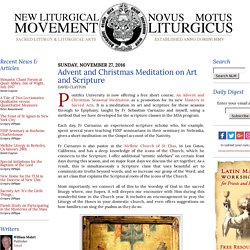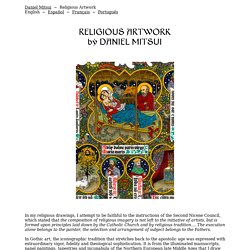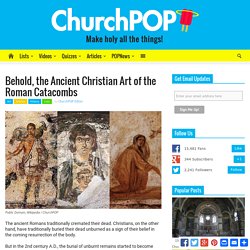

Web Gallery of Art, image collection, virtual museum, searchable database of European fine arts (200-1900) Artist Index Early Christian art Pre-Romanesque art Medieval art Decorative arts Architecture © Web Gallery of Art, created by Emil Krén and Daniel Marx.

Russ' Page. Welcome to the Aidan Hart website - Aidan Hart Sacred Icons. Master of Sacred Arts - Master of Sacred Arts The Master of Sacred Arts combines the study of theology (primarily scripture and liturgy), philosophy, mathematics, architecture, art history and fine arts.

The integration of these subjects in a single program brings to light new facets of each and highlights the relations that exist among the subjects. Thus, students receive a holistic formation rooted in a profound knowledge of each subject. The Way of Beauty. New Liturgical Movement: Advent and Christmas Meditation on Art and Scripture. Online Resources: A Dominican Gradual from 1722Gregory DiPippo Thanks to Fr Innocent Smith O.P., whose work on the Dominican liturgy we have mentioned here various times, for bringing to my attention a new liturgical resource on Google Books, “Cantus Missarum Totius Anni ad Usum Sacri Ordinis FF (Fratrum) Praedicatorum.”

(Chants of the Masses of the Whole Year for the Use of the Sacred Order of Preachers.) Th... Un-censoring the Psalms? Mons. Charles Pope Weighs InGregory DiPippo Mons. A database of gregorian scores. New Liturgical Movement: Audio of Archbishop Sample's Talk on Sacred Music. Christmas 2015 Photopost - Part 2Gregory DiPippo As always, our thanks to all those who have sent in photographs of their liturgies during the Christmas season, with our best wishes to all our readers for a Merry Christmas and Happy New Year!

Our next photopost will be for the Epiphany. How to Read and Sing Gregorian Chant. How to Read and Sing Gregorian Chant Not everyone will agree with all the ideas, conclusions, and methods put forth below.

However, it is hoped that some will find these lessons useful. As time goes on, the lessons will be expanded upon, with even more examples being included. Also, if readers notice errors and mistakes, these can be corrected. — Jeff Ostrowski, June 2012 With a little effort, anybody can learn how to read Gregorian chant! Free Online Catholic Sacred Music Resources. Free Internet Resources for the Catholic Mass Presentation by Jeff Ostrowski • Southeastern Liturgical Music Symposium • 8/25/2012 Don’t feel like reading?

No problem! Just click on the video presentation for a special guided tour. 1. Here is a quick excerpt by Dr. 2. 1963 (Second Vatican Council Sacrosanctum Concilium) — The Church acknowledges Gregorian chant as specially suited to the Roman liturgy: therefore, other things being equal, it should be given first place in liturgical services. 2003 (Pope John Paul II Chirograph on Sacred Music) — With regard to compositions of liturgical music, I make my own the “general rule” that St Pius X formulated in these words: “The more closely a composition for church approaches in its movement, inspiration and savour the Gregorian melodic form, the more sacred and liturgical it becomes; and the more out of harmony it is with that supreme model, the less worthy it is of the temple.” 3. 4. 5. 6. 7.
“Seeing is believing” when it comes to the St. 8. The Crisis of Contemporary Catholic Art and Literature: 4 Reasons Why You Should Care. The Crisis of Contemporary Catholic Art and Literature: 4 Reasons Why You Should Care by Catherine on 2012-06-22 • 3:04 am • 43 Comments Listers, think of all your favorite Catholic authors (Chesterton, Tolkien, O’Connor, Percy, Greene, Powers).

Besides being Catholic, what other common similarity do they all share? The answer is: They’re all dead! (God rest them). Flannery O’Connor acknowledges the plight of the contemporary Catholic author. But I don’t believe that we shall have great religious fiction until we have again that happy combination of believing artist and believing society. I agree with O’Connor that this difference in ideology between author and reader is one of the reasons for the faithful Catholic artist’s plight.
. #1 The World Shouldn’t Define What It Means to Be Catholic. Smith Catholic Art. Daniel Mitsui Art. In my religious drawings, I attempt to be faithful to the instructions of the Second Nicene Council, which stated that the composition of religious imagery is not left to the initiative of artists, but is formed upon principles laid down by the Catholic Church and by religious tradition....

The execution alone belongs to the painter, the selection and arrangement of subject belongs to the Fathers. In Gothic art, the iconographic tradition that stretches back to the apostolic age was expressed with extraordinary vigor, fidelity and theological sophistication. Catholic Artists Directory. The Sacred Arts. The mission of The Fra Angelico Institute is to deepen the prayer life of its participants by evangelizing the truth, goodness, and beauty of God through the understanding and creation of sacred art.
National Association of Pastoral Musicians. Church Music Association of America » Catholic Liturgy, Sacred Music. Behold, the Ancient Christian Art of the Roman Catacombs. The ancient Romans traditionally cremated their dead.

Christians, on the other hand, have traditionally buried their dead unburned as a sign of their belief in the coming resurrection of the body. But in the 2nd century A.D., the burial of unburnt remains started to become fashionable for Romans. Burial within city limits was illegal, and since land for cemeteries outside the city could be expensive, people started digging elaborate tunnels in layers underground to save space. There are 60 known underground chambers in Rome, some of which go as deep as 62 ft (19 m). [See also: Haunting: Get Lost in Rome’s Ancient Christian Catacombs With Google StreetView]